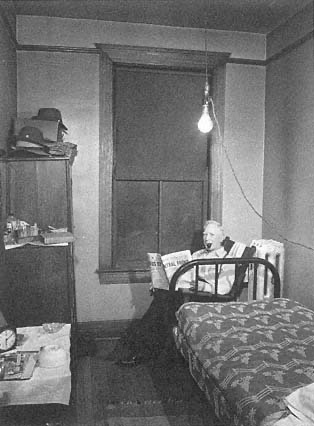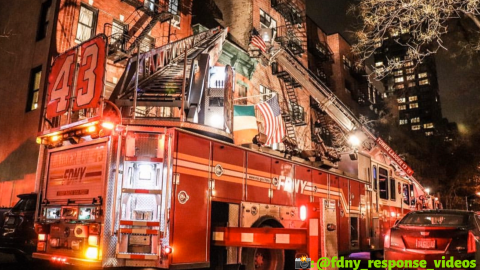Firefighter Proving Grounds
“You got the irons tonight kid”
So, you have a few fires under your belt, and are feeling confident, when the boss finally says, “You got the irons tonight kid.” You think that tonight is the night to prove yourself. This is the moment you've been waiting for since the day you walked into this place. After a busy start to the tour, and a few forcible entry tips from the senior man, you feel like no door in the city could hold you back. For the first time in your career, you truly feel ready to go into battle.
 It's 2:00 AM, and you receive a second due phone alarm for a fire on the fifth floor of a six-story, non-fireproof, occupied multiple dwelling. Falling back to your training, you've been sizing up this fire from the moment you received the alarm. What time is it? Is it still snowing out? It was windy as hell before; all the cards begin to fall. Your company turns the corner as the first due engine transmits the working fire signal. It's go time! You hustle to the lobby as the line is being stretched, only to be met with hysterical occupants fleeing the building. You navigate your way through the chaos, pass the fire floor, and remind the first due officer that you're going above. You arrive at the floor above, conditions are far from ideal and yet, still discerning the task ahead, you ask yourself, "now what?"
It's 2:00 AM, and you receive a second due phone alarm for a fire on the fifth floor of a six-story, non-fireproof, occupied multiple dwelling. Falling back to your training, you've been sizing up this fire from the moment you received the alarm. What time is it? Is it still snowing out? It was windy as hell before; all the cards begin to fall. Your company turns the corner as the first due engine transmits the working fire signal. It's go time! You hustle to the lobby as the line is being stretched, only to be met with hysterical occupants fleeing the building. You navigate your way through the chaos, pass the fire floor, and remind the first due officer that you're going above. You arrive at the floor above, conditions are far from ideal and yet, still discerning the task ahead, you ask yourself, "now what?"
 Sizing up the door
Sizing up the door
Door size-up, when gaining entry to the fire apartment or the floor above, goes far beyond the gap, set, force mentality. We were taught in the early stages of our careers to always “try before you pry.” This is done to ensure that the door is indeed locked before taking on the sometimes tedious task of forcing it. We do not often speak about the size up of the door and whether or not the door is locked. Most firefighters would assume an unlocked door is a good thing, because quick access to locating the seat of the fire with zero delays in searching for victims makes sense. However, understand it can be more challenging than you may think. Although advantageous at times, an unlocked door can be a red flag to an apartment that is outfitted or modified with illegal single room occupancy or “SRO.”

Be cognizant of the fire location, as well as confirming access to and discering the location of fire escapes. In addition, pay close attention to the status of the hose line and the progress of water on the fire. It is imperative to have a grasp on these are key components before committing yourself, and your crew, further into the apartment. Once you have ensured you have a second means of egress, this area becomes your threshold. This threshold will be your point of return when conditions rapidly begin to deteriorate.
Resize the building up from this point and orient yourself from the inside out
Resizing, simply put, is sticking your head out the window and observing how far you have traveled, fire location, and the progression of the line, all the while keeping in mind the isolation of the room. Also, window integrity becomes crucial while operating without a charged hose line. Do not disrupt the flow path in this situation.
 Swimming in the ocean can be used as a simple analogy here to emphasize the importance of resizing the fire building from the inside out: you're swimming in the ocean, all the while thinking you are in fact swimming in the exact spot where you entered the water, only to resurface and realize you have drifted two hotels away. Translate that to the fire floor where we almost always think we've traveled farther than we really have. Knowing the actual distance we've traveled allows us to make more accurate decisions. Discipline yourself to dial it back at fires such as these until you can confirm your second means of egress, or ensure a charged hose line is advancing. Once you've discovered that you are dealing with an SRO, be sure to give that report over the radio.
Swimming in the ocean can be used as a simple analogy here to emphasize the importance of resizing the fire building from the inside out: you're swimming in the ocean, all the while thinking you are in fact swimming in the exact spot where you entered the water, only to resurface and realize you have drifted two hotels away. Translate that to the fire floor where we almost always think we've traveled farther than we really have. Knowing the actual distance we've traveled allows us to make more accurate decisions. Discipline yourself to dial it back at fires such as these until you can confirm your second means of egress, or ensure a charged hose line is advancing. Once you've discovered that you are dealing with an SRO, be sure to give that report over the radio.
Hell, make it URGENT! Your life, as well as mine, depend on it!
When you subscribe to the blog, we will send you an e-mail when there are new updates on the site so you wouldn't miss them.











Comments